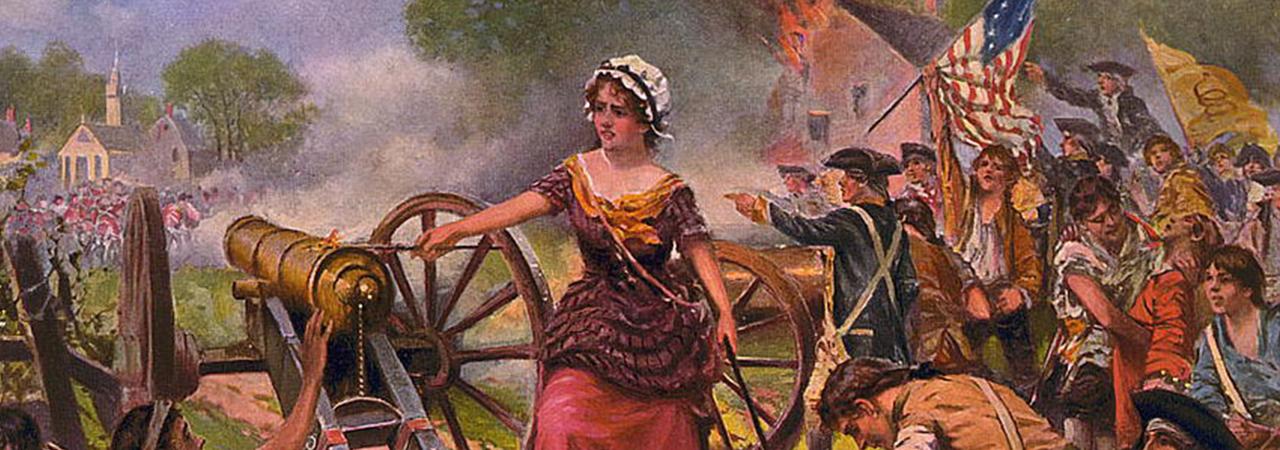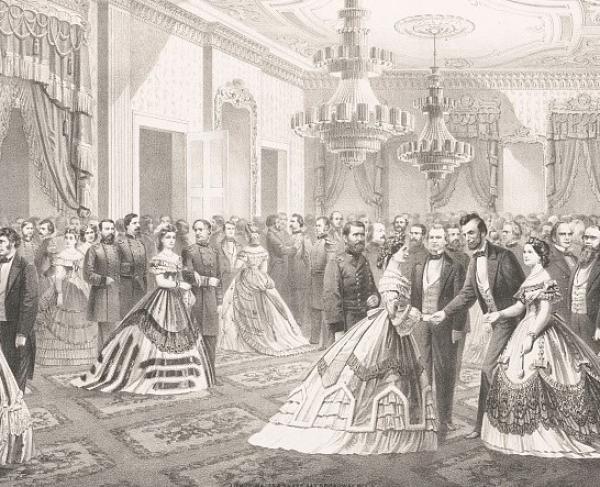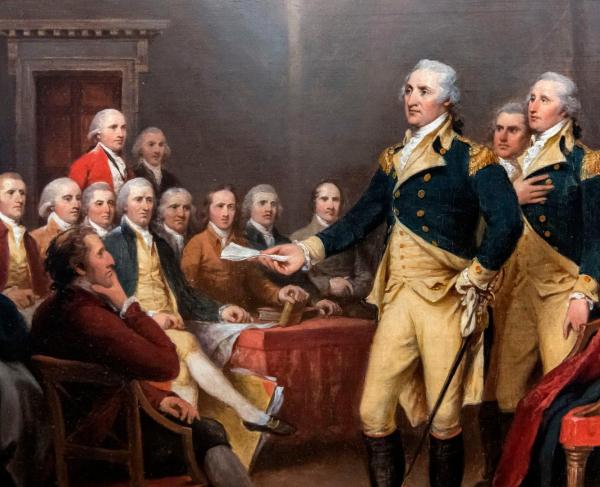
Painting of Molly Pitcher firing a cannon at the Battle of Monmouth in June 1778 by E. Percy Moran
Fact #1: Women followed the armies and provided a sense of normality to military camps.
Often known as camp followers, it was common for women and children to follow the army. Each woman had their own motivations for following the armies: most were the wives, daughters, and/or mothers of male soldiers and wanted to stay close to their loved ones. Others did so in order to provide for themselves, looking for food and protection because they were no longer able to support themselves after their men left for war. There were even provisions for providing these families army rations as they slogged along on the various campaigns. George Washington himself acknowledged the multitude of camp followers, though not always in pleasant terms. He saw them as additional baggage for the army and implemented measures to keep their presence under control, although Martha spent many winters with George in the field. In order to show themselves as more of a contribution than a nuisance, these women offered cooking, cleaning, and laundry services, as well as assisting in field hospitals and serving as seamstresses to repair clothing, tents, and other materials.
Fact #2: Women disguised themselves as men in order to fight in the war.
There are known cases of women who chose to actively join the armies as fighting soldiers. One of the most famous of these women was Deborah Sampson. Originally from Massachusetts, she disguised herself as a man in order to fight in the Continental Army. Serving under the alias of her deceased brother, she fought with the light infantry company of the Fourth Massachusetts Regiment. She was wounded in action in Tarrytown, New York, with two bullets in her thigh and a gash on her forehead. Not wanting her identity to be revealed, she had her head wound treated and then left the field hospital unnoticed. She was later able to extract one of the bullets from her thigh with a knife. Her identity was finally revealed during the summer of 1783 when she contracted a fever while on duty in Philadelphia. After the Treaty of Paris, she was given an honorable discharge from the army. She went on to marry and had three children, settling down back in Massachusetts. To help make ends meet, she often gave public lectures about her wartime service. By the time she died in 1827, she was collecting minimal pensions for her service from Massachusetts and the federal government.
Fact #3: Some women served as spies during the war.
Women were fairly effective spies, for both sides, because they could pass through checkpoints and camps without raising too much suspicion or drawing too much attention to themselves. This was because women were a regular sight due to the presence of camp followers in and around the armies. There are several known women who provided important intel thanks to their spying efforts, such as Lydia Darragh and Hannah Blair. One of the most famous was a British spy named Ann Bates. Living as a schoolteacher with her husband in Philadelphia when the war broke out, she followed her husband to New York City in June of 1778, when he left to fight with the British Army. It was there she took up the mantle of spy and throughout July and August of 1778, disguised herself as a peddler to spy on Washington’s army at White Plans, New York. On her return from each mission, she provided information on the number of soldiers, amount of artillery, level of supplies, and any murmurings of troop movements to her British allies.
Fact #4: Women provided a variety of support for the war effort from the home front.
Women put their skills to use and supported the armies in a variety of important ways. Some women sewed uniforms, clothes, and blankets for soldiers. Some made bullets, as well as rolled and packed cartridges. Still, others raised funds for the war effort. For example, the Ladies Association of Philadelphia, established by Esther de Berdt Reed in January 1780, raised over $7,000 for the Continental Army. Approximately $300,000 in today’s currency, these funds were used to purchase materials to make clothes and blankets for soldiers. Another woman, Mary Draper, aided Continental soldiers by providing food, such as freshly baked bread, and basic provisions whenever they passed through her area of Massachusetts.
Fact #5: Women took care of businesses and properties when their husbands left for war.
Some women did not have the option to follow their husbands when they went off to war. There were businesses, homesteads, families, and properties to look after. At a time when most women were never given the opportunity to take on such responsibility, this was a critical chance to keep their wellbeing, as well as the economy, going. Women managed the harvesting and selling crops, maintained and promoted business inventory and sales, and coordinated labor and budgets. But like multiple American wars in the centuries after the American Revolution, women were expected to go back to their traditional roles at the conclusion of the war.
Fact #6: Women had influence in politics, albeit often through their husbands.
Women like Abigail Adams, the wife of Massachusetts Congressional Delegate John Adams, influenced politics as did Mercy Otis Warren. It was Abigail Adams who famously and voluminously corresponded with her husband while he was in Philadelphia, reminding him that in the new form of government that was being established he should “remember the ladies” or they too, would foment a revolution of their own. Warren, just as politically astute as Adams, was a prolific writer, not only recording her thoughts about the confluence of events swirling around Boston but also dabbling in playwriting. She was a fierce devotee to the patriot cause, writing in December 1774, four months before the war broke out at Lexington and Concord, “America stands armed with resolution and virtue, but she still recoils at the idea of drawing the sword against the nation from whence she derived her origin.”
Fact #7: The first African American woman to be published gained prominence during the war.
Phillis Wheatley, an enslaved African American living in Boston, took up the pen and wrote poetry, becoming one of the first published female authors in America and the first African American woman to be published. Her 1773 collection Poems on Various Subjects, Religious and Moral was popular on both sides of the Atlantic. Her poems focused on patriotism and human virtues. She even wrote a poem about George Washington, “To His Excellency, George Washington” in 1775, which she personally read to him at his Cambridge headquarters in 1776 while he was with the Continental Army in Massachusetts besieging the British. Her visit was the result of an invitation from Washington. Wheatley obtained her freedom upon the death of her master in 1778.
Fact #8: There was a “female Paula Revere.”
Sixteen-year-old Sybil Ludington made her ride on April 26, 1777, during a driving rainstorm, traveling forty miles, and unlike Revere, avoiding capture. She learned that the British were planning to attack nearby Danbury, Connecticut the location of a stockpile of provisions for the Continental Army. Her father, Henry, was a Colonel in the militia in command of 400 men. Not unlike Revere who two years earlier roused the communities outside of Boston to British troops being on the march to seize arms, Ludington spurred her horse, prodding him with a stick to raise the alarm in Putnam County, New York. The British however were successful in their raid on Danbury, but roused by Ludington’s alarm, the Patriots encountered the British at nearby Ridgefield, Connecticut, and were successful in driving them back to Long Island Sound.
Fact #9: Women became compelling historians for the American Revolution.
Whether publishing their own stories or the stories of others, there are several women who wrote compelling historical narratives about the war. In 1805, Mercy Otis Warren published History of the Rise, Progress, and Termination of the American Revolution. In 1827, Ann Darragh, daughter of American spy Lydia Darragh, published the story of her mother’s work. Deborah Sampson, the woman who disguised herself as her deceased brother in order to fight with the army, gave public lectures on her life as a Continental soldier. By providing their dynamic and diverse narrative to the wealth of other male narratives, they give modern historians a richer understanding of a history nearly 250 years old.
Fact #10: Even women could not escape the horrors of the battlefield.
Ordinary women also endured the horrors of the battlefield when those fights came to their doorstep. Sally Kellogg of Vermont and her family escaped the gods of War in 1776 when the War for Independence found its way into the northern reaches of upstate New York and Benedict Arnold’s makeshift fleet and the British Navy clashed on Lake Champlain during the Battle of Valcour Island. As the Kellogg family made good its escape by water, Sally’s family “fell in between Arnold’s fleet and the British fleet,” she later recalled. As the family rowed to safety at Fort Ticonderoga, the exchange of gunfire between ships could be seen and heard Sally recalled, “but happy for us the balls went over us. We heard them whis.” Nevertheless, the war continued to follow the Kellogg family. A year later, after having relocated to Bennington, Vermont the Kelloggs were once more forced to be witnesses to carnage, and once again upon recollection, Sally claimed the results were, “a sight to behold. There was not a house [in Bennington’s vicinity] but was stowed full of wounded.”


